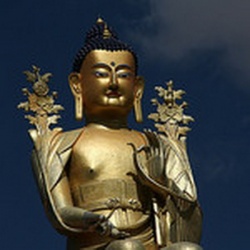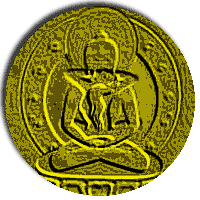Bardo Thodol
The Liberation Through Hearing During The Intermediate State (Standard Tibetan: bardo "liminality"; thodol as "liberation"), sometimes translated as Liberation Through Hearing or transliterated as Bardo Thodol, is a funerary text. It is often referred to in the West by the more casual title, Tibetan Book of the Dead, a name which draws a parallel with the ancient Egyptian Book of the Dead, another funerary text.
The Tibetan text describes, and is intended to guide one through, the experiences that the consciousness has after death, during the interval between death and the next rebirth. This interval is known in Tibetan as the bardo. The text also includes chapters on the signs of death, and rituals to undertake when death is closing in, or has taken place. It is the most internationally famous and widespread work of Tibetan Nyingma literature.
Title
This text is commonly known by its Western title: The Tibetan Book of the Dead. However, Fremantle (2001: p. 20) states:
- ...there is in fact no single Tibetan title corresponding to the Tibetan Book of the Dead. The overall name given to the whole terma cycle is Profound Dharma of Self-Liberation through the Intention of the Peaceful and Wrathful Ones, and it is popularly known as Karma Lingpa's Peaceful and Wrathful Ones. It has been handed down through the centuries in several versions containing varying numbers of sections and subsections, arranged in different orders, ranging from around ten to thirty-eight titles. These individual texts cover a wide range of subjects, including the dzogchen view..., meditation instructions, visualizations of deities, liturgies and prayers, lists of mantras, descriptions of the signs of death, and indications of future rebirth, as well as those that are actually concerned with the after-death state. the [sic.] Tibetan Book of the Dead as we know it in English consists of two comparatively long texts on the bardo of dharmata (including the bardo of dying) and the bardo of existence.... They are called Great Liberation through Hearing: The Supplication of the Bardo of Dharmata and Great liberation through Hearing: The Supplication Pointing Out the Bardo of Existence. Within the texts themselves, the two combined are referred to as Liberation through Hearing in the Bardo, Great Liberation through Hearing, or just Liberation through Hearing,....
Background
According to Tibetan tradition, the Liberation Through Hearing During the Intermediate State was composed in the 8th century by Padmasambhava, written down by his primary student, Yeshe Tsogyal, buried in the Gampo hills in central Tibet and subsequently discovered by a Tibetan terton, Karma Lingpa in the 12th century. There were variants of the book among different sects.
The Liberation Through Hearing During the Intermediate State is recited by Tibetan Buddhist lamas over a dying or recently deceased person, or sometimes over an effigy of the deceased. The name means literally "liberation through hearing in the intermediate state".
The Liberation Through Hearing During the Intermediate State differentiates the intermediate state between lives into three bardos:
- The chikhai bardo or "bardo of the moment of death", which features the experience of the "clear light of reality", or at ::least the nearest approximation of which one is spiritually capable.
- The chonyid bardo or "bardo of the experiencing of reality", which features the experience of visions of various Buddha ::forms (or, again, the nearest approximations of which one is capable).
- The sidpa bardo or "bardo of rebirth", which features karmically impelled hallucinations which eventually result in rebirth. ::(Typically imagery of men and women passionately entwined.)
The Liberation Through Hearing During the Intermediate State also mentions three other bardos: those of "life" (or ordinary waking consciousness), of "dhyana" (meditation), and of "dream" (the dream state during normal sleep).
Together these "six bardos" form a classification of states of consciousness into six broad types. Any state of consciousness can form a type of "intermediate state", intermediate between other states of consciousness. Indeed, one can consider any momentary state of consciousness a bardo, since it lies between our past and future existences; it provides us with the opportunity to experience reality, which is always present but obscured by the projections and confusions that are due to our previous unskillful actions.
Comparison with the Western experience of death
One can perhaps attempt to compare the descriptions of the Liberation Through Hearing During the Intermediate State with accounts of Near-Death Experiences. These accounts sometimes mention a "white light", and helpful figures corresponding to that person's religious tradition. According to the Buddhist teachings, there are four different steps and the "white light" is most probably the last of them; then Mahaparinirvana eternal bliss. The divine beings are Buddhas and dakinis that people see as respective figures of their culture or religious belief.
In an introduction to Evans-Wentz' version, Swiss psychiatrist Carl Jung summarizes his psychological commentary:
- The Bardo Thödol Tibetan Book of the Dead began by being a closed book, and so it has remained, no matter what kind of commentaries may be written upon it. For it is a book that will only open itself to spiritual understanding, and this is a capacity which no man is born with, but which he can only acquire through special training and special experience. It is good that such to all intents and purposes useless books exist. They are meant for those queer folk who no longer set much store by the uses, aims, and meaning of present-day civilisation.
- — Carl Jung

